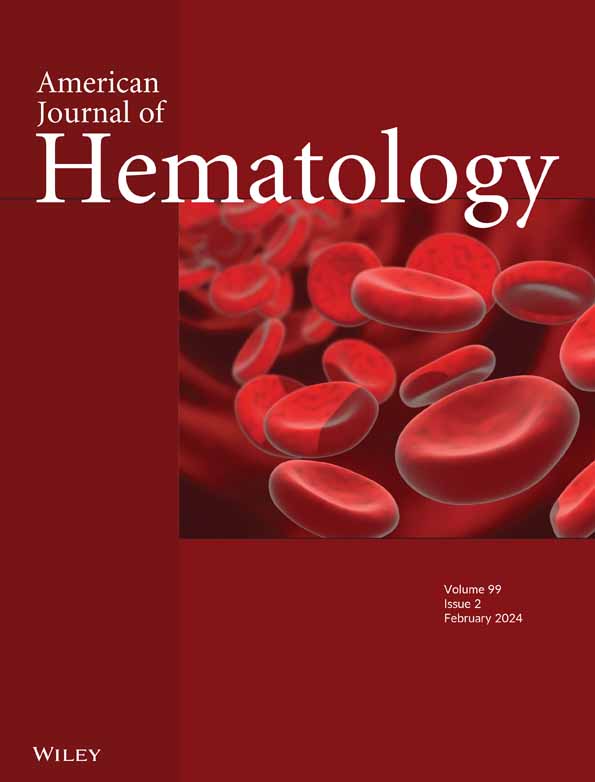纯红细胞发育不全与胸腺肿瘤相关,一项全国性的回顾性研究。
IF 9.9
1区 医学
Q1 HEMATOLOGY
引用次数: 0
摘要
纯红细胞再生不全(PRCA)是胸腺肿瘤(TTs)最常见的自身免疫性细胞减少症。在一项全国性的回顾性研究中,我们纳入了41例患者(22例女性,中位年龄62岁)。PRCA诊断时平均血红蛋白水平为6.6±2.1 g/dL,网织红细胞计数为6±5 × 109/L。PRCA在TT前诊断(8%,中位延迟52个月),同时诊断(46%)或TT后诊断(46%,中位延迟34个月)。14例(34%)患者有明确的Good综合征。无免疫抑制治疗的胸腺切除术提供了单一的可持续的PRCA反应。22例(54%)患者出现多次PRCA复发(中位数2)。当TT诊断时存在PRCA时,PRCA复发的风险较高(p < 0.01),而TT分期、TT复发和Good综合征与PRCA复发无关。皮质类固醇导致77%的初始缓解率,在逐渐减少或停药期间频繁复发。环孢素A的有效率为71%。总的缓解率和缓解时间与皮质类固醇和环孢素a相似。西罗莫司在难治性病例中的缓解率为50%。需要住院治疗的严重感染事件频繁发生(44%)。平均随访50个月后,5例患者(12%)死亡,其中3例死于TT复发。Good综合征与感染、PRCA复发或死亡风险增加无显著相关。我们的研究结果强调了TT和PRCA关联的严重表型。虽然大多数患者在免疫抑制治疗下获得了PRCA应答,但高感染率和胸腺瘤复发是导致严重发病率的原因。本文章由计算机程序翻译,如有差异,请以英文原文为准。
Pure Red Cell Aplasia Associated With Thymic Tumors, a Nationwide Retrospective Study.
Pure red cell aplasia (PRCA) is the most frequent autoimmune cytopenia associated with thymic tumors (TTs). In a nationwide retrospective study, we included 41 patients (22 women, median age 62 years). At PRCA diagnosis, the mean hemoglobin level was 6.6 ± 2.1 g/dL, and the reticulocyte count was 6 ± 5 × 109/L. PRCA was diagnosed before TT (8%, median delay 52 months), simultaneously (46%) or after TT (46%, median delay 34 months). Fourteen patients (34%) had definite Good syndrome. Thymectomy without immunosuppressive treatment provided a single sustainable PRCA response. Twenty-two patients (54%) experienced multiple PRCA relapses (Median 2). When PRCA was present at TT diagnosis, the risk of PRCA relapse was higher (p < 0.01), while TT staging, TT relapse, and Good syndrome were not associated with PRCA relapses. Corticosteroids led to a 77% initial response rate with frequent relapses during taper or at discontinuation. Cyclosporine A provided a 71% response rate. Overall response rates and time to response were similar with corticosteroids and cyclosporine A. Sirolimus led to a 50% response rate in refractory cases. Severe infectious events requiring hospitalizations were frequent (44%). After a mean follow-up of 50 months, five patients (12%) died, three of whom died from TT relapse. Good syndrome was not significantly associated with an increased risk of infection, PRCA relapse, or death. Our findings highlight the severe phenotype of the association of TT and PRCA. While most patients achieve PRCA response under immunosuppressive therapy, high infection incidence and thymoma relapse are responsible for severe morbidity.
求助全文
通过发布文献求助,成功后即可免费获取论文全文。
去求助
来源期刊
CiteScore
15.70
自引率
3.90%
发文量
363
审稿时长
3-6 weeks
期刊介绍:
The American Journal of Hematology offers extensive coverage of experimental and clinical aspects of blood diseases in humans and animal models. The journal publishes original contributions in both non-malignant and malignant hematological diseases, encompassing clinical and basic studies in areas such as hemostasis, thrombosis, immunology, blood banking, and stem cell biology. Clinical translational reports highlighting innovative therapeutic approaches for the diagnosis and treatment of hematological diseases are actively encouraged.The American Journal of Hematology features regular original laboratory and clinical research articles, brief research reports, critical reviews, images in hematology, as well as letters and correspondence.

 求助内容:
求助内容: 应助结果提醒方式:
应助结果提醒方式:


